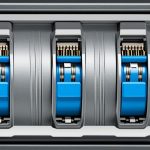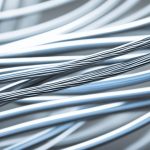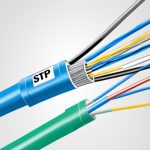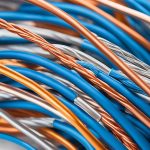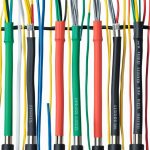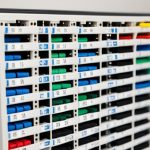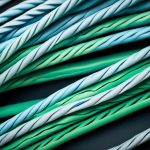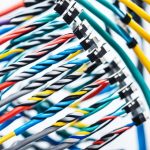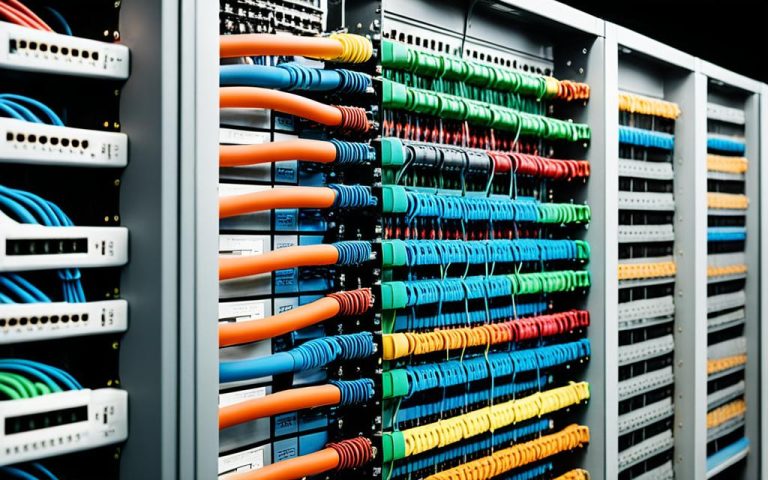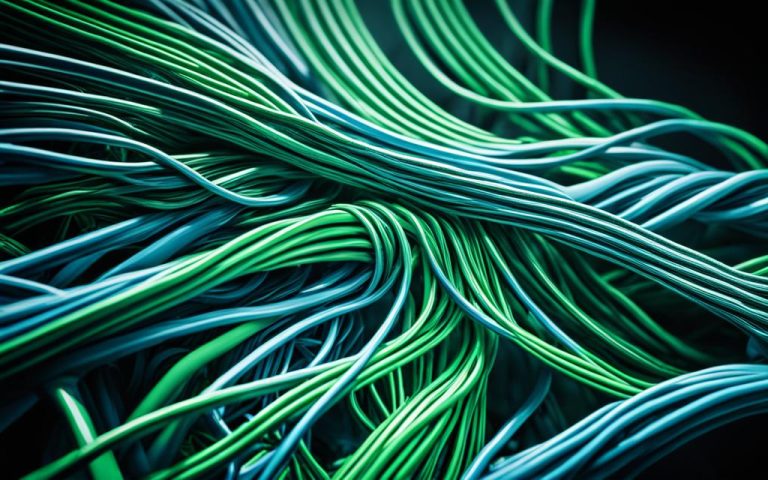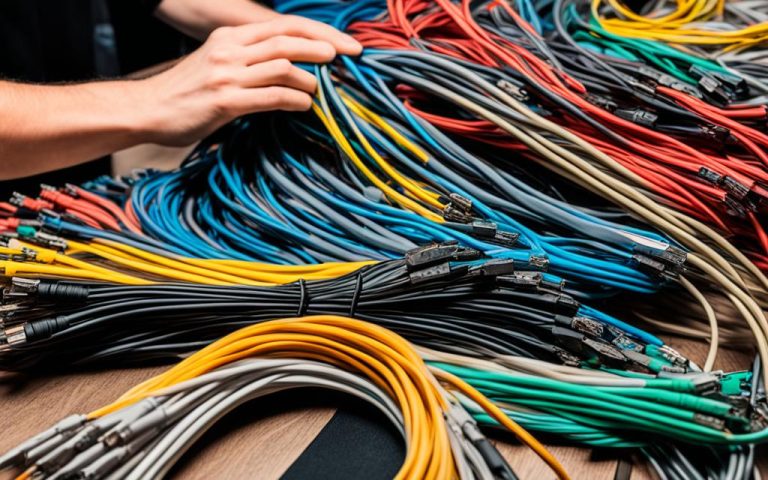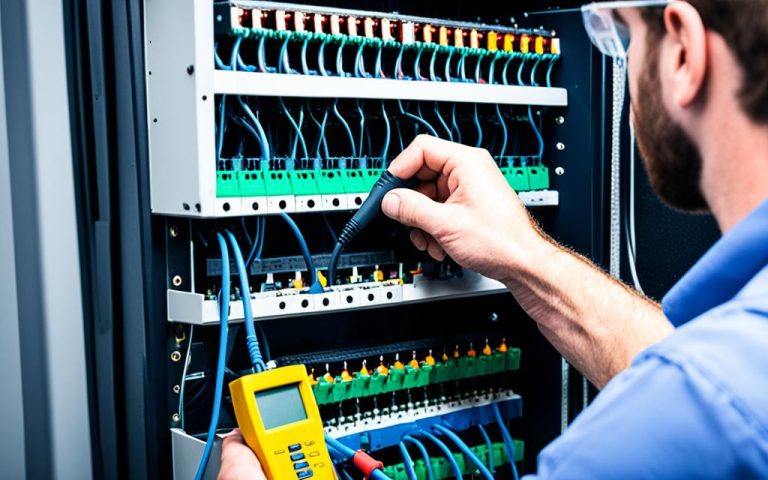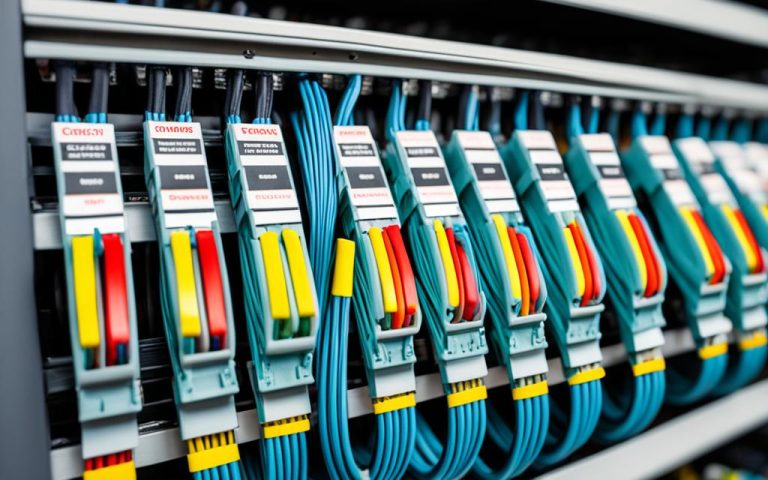Twisted-pair cables are an essential component of modern wired networks and communication systems. These cables, consisting of one or several pairs of copper wires twisted together, are used in various applications, including the Twisted Pair Cable Network, twisted-pair cabling systems, and telecommunications. The twisting design of these cables helps minimize electromagnetic radiation, resist external interference, and limit interference with adjacent cables.
When it comes to types of twisted-pair cabling systems, there are two main categories: unshielded twisted pair (UTP) and shielded twisted pair (STP). UTP cables are commonly used in telephone lines and local area networks (LANs), while STP cables are preferred in environments requiring enhanced protection against signal interference.
To understand the different types and uses of twisted-pair cables, it is important to explore the structure, conductors, categories, and benefits they offer. Let’s delve into each aspect of twisted-pair cables and uncover the secrets behind their effectiveness in network communication.
Structure and Conductors of Twisted-Pair Cables
Twisted-pair cables are a fundamental component of modern communication and networking systems. Understanding the structure and conductors of these cables is essential for designing and implementing effective network solutions.
Twisted-pair cables can be categorized based on their conductor type—solid conductor twisted-pair cable and stranded conductor twisted-pair cable.
Solid Conductor Twisted-Pair Cable
Solid conductor twisted-pair cables consist of a single strand of copper wire. This conductor design offers superior transmission performance over long distances. The solid conductor creates a secure and stable connection, making it suited for permanent lines and backbone cabling.
The solid conductor twisted-pair cable is commonly terminated using an insulation displacement connector (IDC). This connector allows for efficient and reliable termination without the need for stripping or soldering. The insulation displacement technique ensures a solid and steady connection, enhancing the overall performance of the cable.
Stranded Conductor Twisted-Pair Cable
Stranded conductor twisted-pair cables are composed of multiple smaller wires woven together. This design provides flexibility and increased resistance to physical stress. However, stranded conductors have higher signal attenuation compared to solid conductors, limiting their suitability for long-distance transmissions.
These cables are commonly used in patch cord production for local connections, such as connecting devices within a room or building. The flexibility of stranded conductors makes them ideal for applications where frequent movement or vibration is expected.
Overall, both solid conductor and stranded conductor twisted-pair cables play significant roles in network infrastructure. The choice between the two depends on factors such as distance requirements, signal integrity, and installation ease.
Categories of Twisted-Pair Cabling Systems
In networking and communication applications, twisted-pair cables are categorized based on their shielding and rated speeds. Two common types of twisted-pair cables are unshielded twisted pair (UTP) and shielded twisted pair (STP).
UTP cables are the most commonly used twisted-pair cables in Ethernet networks. They offer several advantages, including low cost, easy installation, flexibility, and support for high data transfer speeds of up to 1 gigabit per second (Gbps). These cables are suitable for various applications and are widely used in homes, offices, and data centers.
On the other hand, STP cables provide better protection against signal interference. They have a braided, wired mesh that encases each pair of insulated copper wires, offering additional shielding. However, STP cables are more expensive and can be more challenging to connect compared to UTP cables.
Both UTP and STP cables have different categories based on their rated speeds. The categories for UTP cables include Cat1 to Cat8, while STP cables range from Cat1 to Cat7a. Each category offers varying levels of performance and suitability for specific applications.
UTP Cable Categories
The following table shows the different UTP cable categories and their respective rated speeds:
| Cable Category | Rated Speed |
|---|---|
| Cat1 | Voice-only applications, no data transmission |
| Cat2 | 4 Mbps |
| Cat3 | 10 Mbps |
| Cat4 | 16 Mbps |
| Cat5 | 100 Mbps |
| Cat5e | 1 Gbps |
| Cat6 | 1 Gbps |
| Cat6a | 10 Gbps |
| Cat7 | 10 Gbps |
| Cat7a | 40 Gbps |
| Cat8 | 25 Gbps or 40 Gbps |
STP Cable Categories
The following table illustrates the different STP cable categories and their respective rated speeds:
| Cable Category | Rated Speed |
|---|---|
| Cat1 | Voice-only applications, no data transmission |
| Cat2 | 4 Mbps |
| Cat3 | 10 Mbps |
| Cat4 | 16 Mbps |
| Cat5 | 100 Mbps |
| Cat5e | 1 Gbps |
| Cat6 | 1 Gbps |
| Cat6a | 10 Gbps |
| Cat7 | 10 Gbps |
| Cat7a | 40 Gbps |
Understanding the different categories of twisted-pair cabling systems is essential for selecting the appropriate cables for specific networking needs.
Twisting in Twisted-Pair Cables
Twisted-pair cables incorporate a unique twisting mechanism to effectively reduce noise, signal interference, and crosstalk during data transmissions. The twisting action plays a vital role in enhancing the performance and reliability of these cables, offering better noise immunity, lower signal attenuation, and improved overall signal quality.
The process of twisting introduces several benefits that contribute to noise reduction in twisted-pair cables. By twisting the wires together, the cable design minimizes the impact of external electromagnetic interference (EMI). The twisting action reduces the strength of noise signals and cancels out the effects of external waves by moving a portion of the noise in the same direction as the signal, and another portion in the opposite direction.
This design feature significantly enhances the cables’ noise immunity, allowing for clean and effective data transmission. It also reduces the opportunity for crosstalk, which occurs when signals interfere with adjacent cables, further enhancing the cable’s performance.
When a signal is transmitted through twisted-pair cables, the receiver can calculate the voltage difference between the two wires, enabling efficient data retrieval. This voltage difference helps to minimize the impact of noise and interference, resulting in reliable and accurate signal transmission.
Compared to coaxial cables, twisted-pair cables offer superior noise reduction capabilities, making them a preferred choice in various applications. The twisting mechanism incorporated into twisted-pair cables is instrumental in providing noise immunity, ensuring signal integrity, and maintaining optimal performance in networking and communication systems.
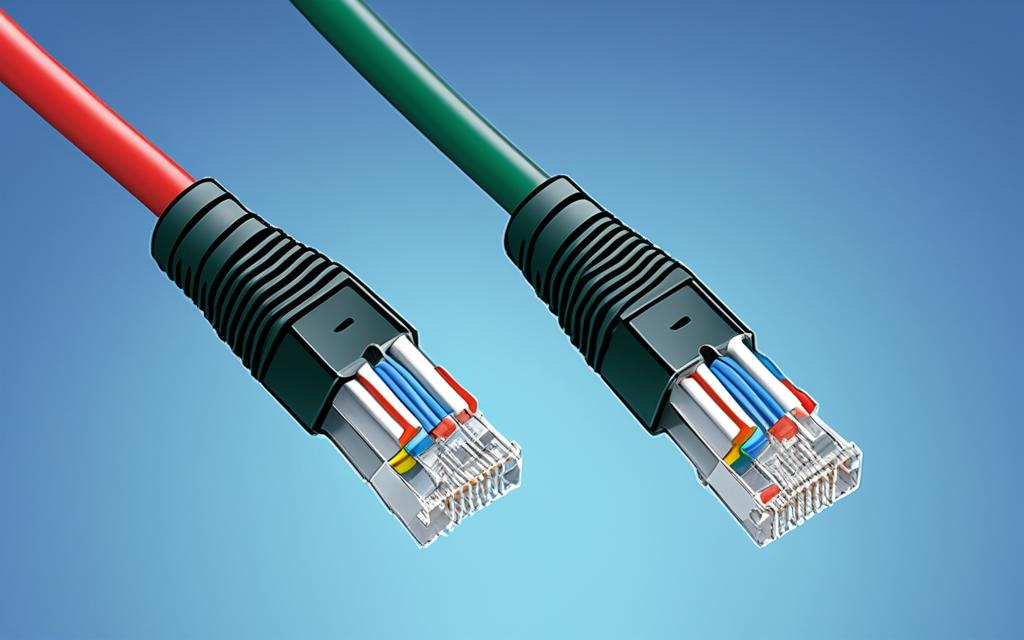
Twisted-Pair Cable Categories
Twisted-pair cables are categorized into different categories based on their transmission speeds and performance. These categories are known as UTP cable categories. Let’s take a closer look at each category:
Cat1
Cat1 cables are primarily used for traditional telephone systems. They have a low data rate capability and are not suitable for high-speed data transmission.
Cat2
Cat2 cables are an improvement over Cat1 and can support data rates of up to 4 Mbps. They are commonly used for token ring networks.
Cat3
Cat3 cables are widely used in Ethernet networks and can support data rates of up to 10 Mbps. They are often used for voice and data applications in small networks.
Cat4
Cat4 cables can support data rates of up to 16 Mbps. They were primarily used for Token Ring networks but have been largely replaced by newer cable categories.
Cat5
Cat5 cables, also known as Ethernet cables, can support data rates of up to 100 Mbps. They are commonly used in home and office networks.
Cat5e
Cat5e cables are an enhanced version of Cat5 and offer improved performance. They can support data rates of up to 1 Gbps, making them ideal for high-speed Ethernet networks.
Cat6
Cat6 cables are designed to support data rates of up to 10 Gbps over short distances. They have stricter specifications for crosstalk and system noise, making them suitable for demanding applications.
Cat6a
Cat6a cables are an enhanced version of Cat6 and can support data rates of up to 10 Gbps over longer distances. They are commonly used in data centers and high-speed networks.
Cat7
Cat7 cables are designed to support data rates of up to 10 Gbps over larger distances. They have better shielding and reduced crosstalk compared to previous categories, making them suitable for high-performance networks.
Cat7a
Cat7a cables are an improved version of Cat7 and can support data rates of up to 40 Gbps. They are commonly used in data centers and high-speed applications that require maximum performance and reliability.
Cat8
Cat8 cables are the latest addition to the UTP cable categories and can support data rates of up to 40 Gbps or even 100 Gbps. They are designed for high-speed data centers and other demanding applications.
Below is a summarized table of the UTP cable categories:
| Category | Data Rate | Applications |
|---|---|---|
| Cat1 | Low | Traditional telephone systems |
| Cat2 | Up to 4 Mbps | Token ring networks |
| Cat3 | Up to 10 Mbps | Ethernet networks, voice and data applications |
| Cat4 | Up to 16 Mbps | Token Ring networks |
| Cat5 | Up to 100 Mbps | Home and office networks |
| Cat5e | Up to 1 Gbps | High-speed Ethernet networks |
| Cat6 | Up to 10 Gbps | High-performance networks |
| Cat6a | Up to 10 Gbps | Data centers, high-speed networks |
| Cat7 | Up to 10 Gbps | High-performance networks |
| Cat7a | Up to 40 Gbps | Data centers, high-speed applications |
| Cat8 | Up to 40 Gbps or 100 Gbps | Data centers, high-speed applications |
Note: The above data rates are the maximum theoretical capabilities of each category and may vary depending on various factors such as cable length and interference.
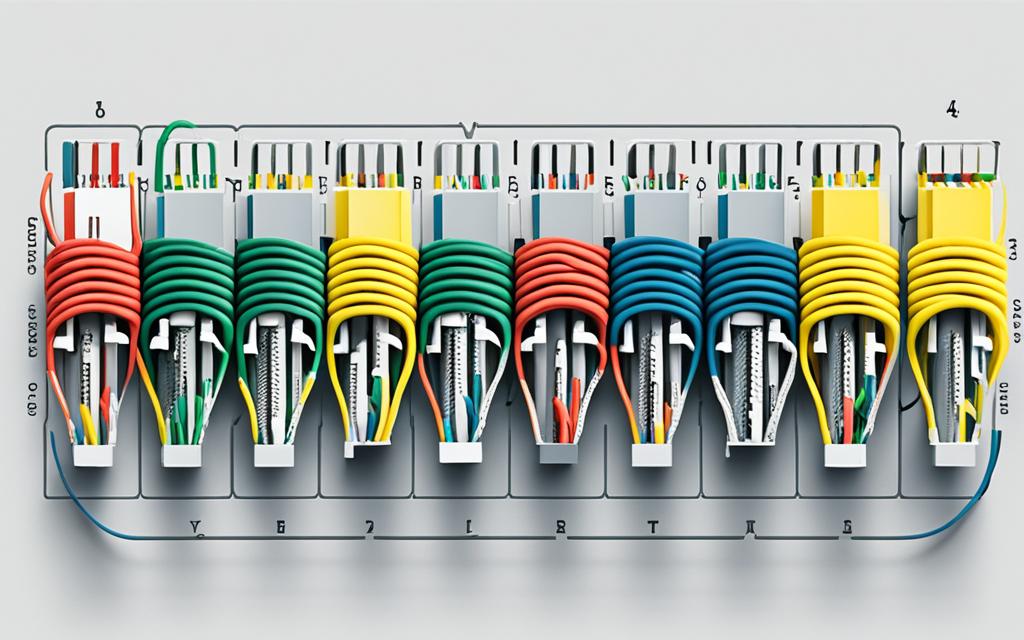
Understanding the different UTP cable categories can help you choose the right cable for your specific requirements. Whether you need a cable for a small office network or a high-performance data center, there is a UTP cable category suitable for your needs.
Unshielded Twisted Pair (UTP) and Shielded Twisted Pair (STP)
When it comes to twisted-pair cables, two primary options are commonly used in Ethernet networks: Unshielded Twisted Pair (UTP) and Shielded Twisted Pair (STP) cables. Understanding the advantages and disadvantages of both cable types is crucial in making informed decisions for your network infrastructure.
UTP Cable:
UTP cables are widely used due to their cost-effectiveness, ease of installation, and flexibility. These cables are capable of supporting high data transfer speeds and are typically suitable for transmission distances of up to 100 meters. UTP cables are ideal for shorter distance applications, such as connecting devices within the same room or office. They are commonly used in residential and commercial settings, providing reliable connectivity for computers, printers, and other network devices.
However, UTP cables do have their limitations. One of the main disadvantages is their vulnerability to signal interference. Without internal shielding, UTP cables are more prone to electromagnetic interference (EMI) and crosstalk, which can impact their overall performance. As a result, UTP cables are not suitable for long-distance transmissions or environments with high levels of EMI.
“UTP cables offer cost-effective and flexible solutions for Ethernet networks, but their susceptibility to signal interference makes them less suitable for long-distance transmissions.”
STP Cable:
STP cables, on the other hand, provide enhanced protection against signal interference. They feature a wire mesh or foil shield that surrounds each pair of insulated copper wires, reducing the impact of external electromagnetic signals and minimizing crosstalk. This shielding significantly improves the signal integrity and overall performance of the cable.
However, the added shielding comes at a cost. STP cables are generally more expensive than UTP cables and require proper grounding to ensure optimal performance. Additionally, terminating STP cables can be more complex and time-consuming due to the additional shielding requirements.
“STP cables offer superior protection against signal interference but come at a higher cost and require more complex termination.”
When deciding between UTP and STP cables, consider the specific requirements and environment of your network. UTP cables are suitable for most standard Ethernet applications, providing a cost-effective and easy-to-install solution. On the other hand, STP cables offer additional protection in environments with high levels of EMI or where signal integrity is critical. Consider consulting with a professional network installer or technician to determine the best cable type for your specific needs.
UTP vs. STP Comparison:
| UTP Cable | STP Cable |
|---|---|
| Cost-effective | Higher cost compared to UTP |
| Easy installation | More complex termination |
| Flexible | Requires proper grounding |
| Suitable for shorter distance transmissions | Provides enhanced protection against signal interference |
| Vulnerable to signal interference | More resistant to EMI and crosstalk |
Note: The provided image showcases the UTP and STP cables, visually depicting their differences and characteristics.
Uses of Twisted-Pair Cables
Twisted-pair cables are a versatile solution for various networking and communication systems. They find extensive use in different applications, such as LANs, Ethernet networks, DSL lines, telephone lines, and security camera systems.
LANs: Twisted-pair cables are commonly used in LANs to establish connections between computers, switches, routers, printers, IP cameras, and Power over Ethernet (PoE) devices. These cables ensure seamless data transfer and reliable communication within the network. The implementation of structured cabling systems within these environments leverages twisted-pair cables for their flexibility and efficiency, providing a standardized architecture that enhances the performance and scalability of network infrastructures.
Ethernet networks: Twisted-pair cables play a crucial role in Ethernet networks, enabling high-speed data transfer over short to moderate distances. Whether it is a small office network or a large-scale enterprise infrastructure, twisted-pair cables provide the necessary connectivity for efficient network operations.
DSL lines: Twisted-pair cables are an essential component of DSL connections, serving as the medium for providing internet connectivity over standard telephone lines. They facilitate the transmission of digital signals, enabling high-speed internet access for both residential and commercial users.
Telephone lines: Traditional telephone lines also rely on twisted-pair cables for voice communication. These cables ensure clear and reliable audio transmission, allowing individuals to communicate effectively over long-distance telephone networks.
Security camera systems: Twisted-pair cables are extensively used in security camera systems for the transfer of audio and video signals. By connecting cameras to recording devices or monitoring stations, these cables enable efficient surveillance and monitoring of residential, commercial, and public spaces.
“Twisted-pair cables serve as the backbone of modern networking and communication infrastructure, empowering seamless connectivity and reliable data transfer across various applications.”
Applications of Twisted-Pair Cables
| Application | Description |
|---|---|
| LANs | Connect computers, switches, routers, printers, IP cameras, and PoE devices |
| Ethernet networks | Enable high-speed data transfer over short to moderate distances |
| DSL lines | Provide internet connectivity over standard telephone lines |
| Telephone lines | Facilitate voice communication over long-distance telephone networks |
| Security camera systems | Transfer audio and video signals for surveillance and monitoring |
Conclusion
Twisted-pair cables are a vital component of modern communication and networking systems. They offer reliable and efficient data transmission, catering to various applications through their different categories and types. Whether it’s for LANs, Ethernet networks, DSL lines, telephone lines, or security camera systems, twisted-pair cables play a crucial role in enhancing communication and connectivity.
The choice between unshielded twisted pair (UTP) and shielded twisted pair (STP) depends on specific requirements and the desired level of protection. UTP cables are cost-effective, easy to install, and flexible, making them ideal for most Ethernet networks. On the other hand, STP cables provide enhanced protection against signal interference but come at a higher cost and complexity in termination.
Understanding the various categories and applications of twisted-pair cables empowers you to make well-informed decisions when implementing network solutions. By leveraging the right twisted-pair cable for your network needs, you can ensure efficient data transmission and reliable connectivity. Whether it’s transferring high-speed data in a LAN, establishing internet connectivity through DSL lines, enabling voice communication via telephone lines, or transmitting audio and video signals in security camera systems, twisted-pair cables serve as a reliable backbone for seamless communication.
FAQ
What are twisted-pair cables?
Twisted-pair cables are a type of cable used in networking and communication applications. They consist of one or several pairs of copper wires that are twisted together. The twisting helps minimize electromagnetic radiation, resist external interference, and limit interference with adjacent cables.
What types of twisted-pair cables are there?
There are two types of twisted-pair cables: unshielded twisted pair (UTP) and shielded twisted pair (STP).
What is the difference between solid conductor and stranded conductor twisted-pair cables?
Solid conductor twisted-pair cables have a single strand of copper, offering better transmission performance over long distances. They are suitable for permanent lines and backbone cabling. On the other hand, stranded conductor twisted-pair cables consist of multiple smaller wires woven together. They have high signal attenuation and are typically used in patch cord production for local connections.
How are twisted-pair cables categorized?
Twisted-pair cables are categorized based on their shielding and rated speeds. The categories range from Cat1 to Cat8.
Why is twisting important in twisted-pair cables?
Twisting is introduced in twisted-pair cables to reduce noise, signal interference, and crosstalk during transmissions. The twisting provides better noise immunity, lower signal attenuation, and improved overall performance of the cable.
What are the uses of twisted-pair cables?
Twisted-pair cables have a wide range of applications in networking and communication systems. They are used in LANs, Ethernet networks, DSL lines, telephone lines, and security camera systems.
What are the advantages and disadvantages of unshielded twisted pair (UTP) and shielded twisted pair (STP) cables?
UTP cables are cost-effective, easy to install, and flexible. They support high data transfer speeds and are suitable for transmission distances of up to 100 meters. However, they are vulnerable to signal interference and not suitable for long-distance transmissions. STP cables provide better protection against signal interference but are more expensive and difficult to terminate.
What are the different categories of twisted-pair cables?
Twisted-pair cables are categorized into different categories based on their transmission speeds and performance. The categories include Cat1, Cat2, Cat3, Cat4, Cat5, Cat5e, Cat6, Cat6a, Cat7, Cat7a, and Cat8, each with specific data rate capabilities and applications.


